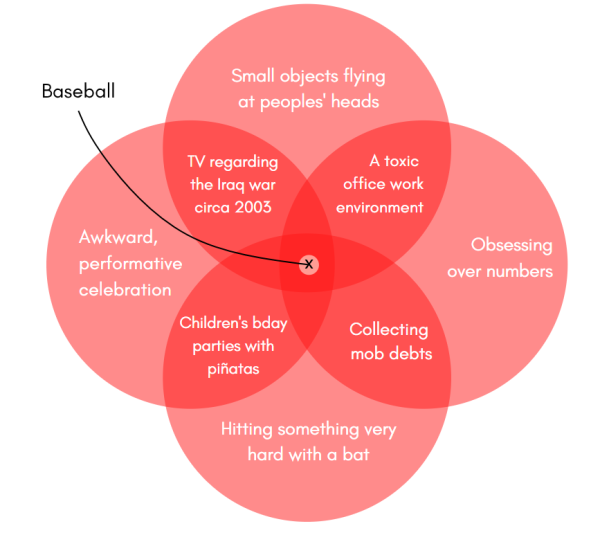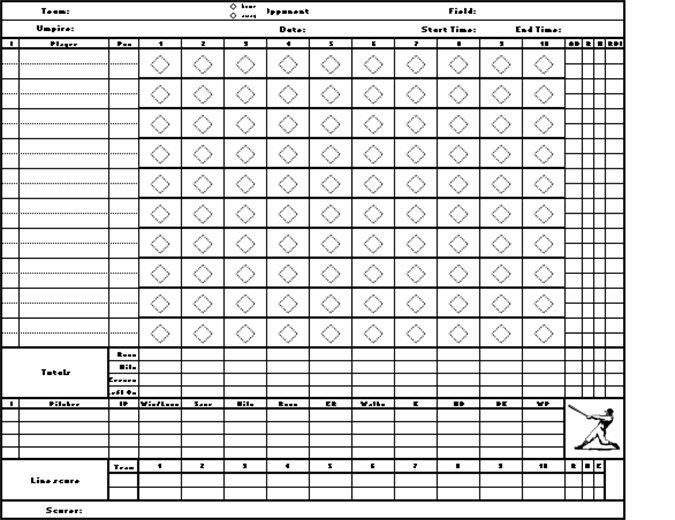

What is baseball?
Well, it’s a game men play where they throw balls at one another and hit those balls with bats and run very quickly between white rubber pads planted set distances apart within beautifully groomed, symmetrical fields.

It’s also something else: an extrapolated mythos, a collection of larger-than-life stories played out since the 1850s or thereabouts by basically normal, beer-drinking, turkey-leg-eating dudes who’ve penetrated the cultural landscape of the USA to a degree of notoriety and recognition and - most importantly - deserved interest greater than that of the celebrity athletes from any other sport. In other words, the menThis review mostly covers Major League Baseball, which is populated exclusively with male players, although it hasn’t always been. Baseball is a sport where attributes commonly connected to sex, like one’s maximum bench press weight, are not as closely linked to success as they might be in like, football. Players throughout the sport’s history have notably been of varying weights, heights, BMIs, muscle masses, degrees of mental acuity, etc. In 1931, before her contract was voided for totally bullshit reasons, Jackie Mitchell, a 17-year-old female pitcher, struck out Babe Ruth and Lou Gehrig. Carey Schueler was drafted (but never signed) in 1993. Perhaps more women will play for the MLB in the future. For more info see here. of baseball are just like us in appealing ways, but they’re also fascinatingly weird individuals, and that juxtaposition allows for a fanatical fandom and strange, insular community unlike any other.
It’s difficult to define a community you’re not part of, and I’m not going to try to define this one. Actually, should I? Okay, here I go: the community of baseball enthusiasts is defined by things like their degree of participation in the most tremendous, dramatic moments of the game: balls and occasionally bats or bat fragments enter the stands with frequency, and are caught or result in injury. These ejections from the game’s physical mesh, alongside signed or otherwise significant memorabilia and jerseys from particular games/eras, comprise the uniquely historical, game-used cultural artifacts of baseball. In other words, a significant portion of the objects baseball fans keep around to remind themselves they like baseball are discharged from the actual game into their possession. Basically anyone who considers themselves a real Fan of the Game and goes and sees games in person, regularly, has likely caught one or more balls and displays them proudly and conspicuously within their domicile.
Another component: rote memorization and regurgitation of stats and historical facts; not really a distinguishing factor among sports fans, but I think this attribute is more important here than in like for example hockey or tennis. A true Fan is expected to know not just their favorite players’ batting averages and runs batted in (the latter of which I just learned, to my chagrin, is different from home run count) and what teams they played for and stuff, but also certain tidbits for all notable members of their chosen or regionally assigned team. They’re supposed to know their team’s members’ names, and numbers, how long they’ve been on the team & from whence they came, who’s got what injuries, who is gradually becoming more or less effective, etc. These fans often know these things going back many years.
There’s also the phenomenon of recreational scorekeeping, where viewers keep score of the game. For fun, on little cards.

But so anyway, now you know what baseball is, and you know who plays it, and you know who watches them play it, but you don’t really know baseball. The soul of the sport isn’t a tangible piece of transmissible info but is instead more of a shimmering aura, held, immobile, within moments frozen in time, like a snowglobe or post-impressionist painting of many individuals in motion, brightly colored and more graceful from a distance: A tow-headed youth races up the stands, skinning his shin on the way to the hot dog vendor; he throws the man a dollar and sprints back to the top of the staircase to see that a fly ball has landed just below his seat, where a crowd of children gathers, searching, before some guy in his 40s wades through and triumphantly grabs the ball from the throng. An enormous man, the most famous by bounds in the stadium, sits fanning himself in a box, preparing for the moment when he will walk out onto the field to raucous applause, look to and fro, wave, and walk back off the field. A pitcher spits in his glove. A batter, staring directly at him, spits into the dirt. The pitcher spits into the dirt. The batter spits again, and so on.
What are these people feeling? What are they chewing? Why have the watchers left their homes to sit in uncomfortable seats and eat overpriced food washed down by warm, imported beer, all to watch a game with a longer runtime than The Irishman? Why do they know the names of all the players, and those players’ effectiveness at tasks like batting and throwing balls long distances at high speeds? Why all this, when 90% of the game is spent waiting for something to happen?
It’s because, beyond the moments of brief chaotic action, there exists a metadimension, and fully comprehending it requires a lifetime of dedication.
How does one comprehend it? When I was young, maybe 14, I caught a glimpse. My father had taken my brother and me sailing with one of his old work friends. I grew annoyed with the seaspray and being tasked with moving around ropes made of weird white plastic that stung my hands, and I retreated to the cabin, where I found a bookI tried to find it again, but it seems to be lost to the ages. Sorry. about notable players from baseball’s days of yore and the crazy shit that surrounded their ridiculous lives. I’d played, poorly, in local leagues as a child, but I’d never seen a professional game and had no knowledge of the sport’s lore.
From this collection of tall-ish tales, I read that Ty Cobb learned to pitch by chucking rocks at the heads of turkeys in his Georgian backyard. I pored through Yogi Berra’s many witticisms, and shouted some up through the cabin’s doorway to my dad, who didn’t give a shit. I learned the terribly sad story of Shoeless Joe Jackson and his lifetime ban from the sport by legendary commissioner Kenesaw Mountain Landis. (All these peoples’ wiki pages, especially Cobb’s, are fun reads even if you don’t give a shit about baseball.)
There are the lucky ones, like the pitcher Dock Ellis, who, not realizing it was a game day, dropped a bunch of LSD and then proceeded to pitch a no-hitter (something that has only occurred 300 or so times in the history of the MLB). There are the less lucky ones, like Len Koenecke, who got discharged from the Dodgers in 1935 for excessive drinking and disorderliness, then got kicked off his flight home for, again, excessive drinking and disorderliness, at which point he slept off the booze in an airport, bought another plane ticket, and, after a disagreement with the pilot, attempted to hijack the plane, whereupon he was hit on the head repeatedly with a fire extinguisher and died.
Then there are countless legendary hot streaks and storied Curses, like the one that prevented the Red Sox from being properly managed between the years of 1918 and 2004.
So, is this baseball? A history of unusual people and strange coincidences, codified in fandom and told to each generation as if around a paleolithic fire? That’s certainly a large part of it, but we haven’t really talked about the magic yet.
Take this (all this) with a grain of salt, because I’m not a true obsessive and haven’t spoken to any, but this is the thing casual fans miss: baseball is magical. I don’t mean like, you have wonderful experiences playing and watching the game and that these constitute a sort of metaphorical magic; there is literal, actual Magic going on.
I had an inkling of this based on the book I read on that sailboat, plus some anecdotes I’d picked up about players’ ridiculous superstitions, like former Red Sox third baseman Wade Boggs always eating chicken before playing, or how Phillies right fielder Bryce Harper apparently takes seven showers before each game, and is also a Mormon, no offence. This solidified into a theory after I took a sports literature course my freshman year of college and, hoping for brownie points but also to read something more out there than Moneyball, elected for the final essay to study my professor’s favorite book, "The Seventh Babe" by Jerome Charyn, a book about a left-handed third-baseman on the 1940’s Red Sox that’s pretty much all about the Magic.For the record, the three best baseball books I’ve read are in no particular order the aforementioned Charyn; “The Natural,” which is way more psychedelic than the movie; and Chad Harbach’s “The Art of Fielding.” All of these are some degree of magical realist.
By definition, the Magic cannot be defined or even really spoken about directly. You have to approach it from the side, like a feral ungulate. Charyn’s technique is part structural - the first of the novel’s nine chapters has a hundred pages, the next has only 37, and so on, mirroring the flow of time in an actual game - and part literal: his book features actual magic practiced by a barnstorming team. It’s not the Magic, it’s a stand-in. I don’t recall much of “The Natural,” I read it fucking ages ago, but if I remember correctly it involves an evil dwarf and a woman who shoots promising athletes with silver 22-caliber bullets: rarely present (if potentially extant) features of actual life.
The thing about the Magic is, it’s not some hidden quality that you can only uncover after years of fandom and fruitless searching. It’s in everything: in the weird outliers of statistics (in 1920, Babe Ruth hit more home runs than any other team in the American League), in the weird behaviors and superstitions and attributes of the players (the aforementioned Ty Cobb, arguably the greatest player in baseball history, seemingly attacked basically any available person to the point where he once jumped into a crowd during a game to beat up a heckler who had no hands, and also, apocryphally, beat a man to death on the street in Detroit).
It’s in the science and pseudoscience, the literal physical laws governing baseball. A prime example is juiced ball theory, a conspiracy first floated in the ‘90s suggesting the league was altering baseballs to increase the distance of hits and the number of runs.“Researchers Brian J. Love and Michael L. Burns, writing for The Conversation, identified other factors that could be contributing to the changing baseball composition, including lowering quality of cork supplied worldwide due to climate change and new standards for humidity control for storing baseballs at MLB stadiums.” See here. The theory was vehemently denied at all levels and was the target of much ridicule, but it continued underground for many years until 2019, when the universally despised (for completely unrelated reasons) commissioner, Rob Manfred, basically confirmed the balls had changed and now had less drag.

It’s even in moments of pure, seemingly nonmagical joy that ripple out past their original dimensions, like when the ancient, meatball-headed Don Zimmer ran onto the field during a bench-clearing brawl and attacked Pedro Martinez, a world-class athlete in the physical prime of his life, and got predictably tossed to the side like a rotund septuagenarian dishrag. That might have nothing to do with the Magic, now that I think about it, but it’s worth watching. The announcers got so upset. They kept saying “That’s awful. That’s terrible.” It’s hilarious. Go watch it right now, I’ll wait. Good, right?
Baseball is the great American pastime but isn’t uniquely AmericanWhile reading through an early draft of this review, my friend Jon pointed out that baseball is perhaps most beloved by the citizens of revolutionary anti-colonial nation states, for example post-Revolutionary War America, Haiti, postwar Japan, etc. The global south has embraced baseball to such a significant degree that an enormous number of star players in American leagues hail from places like the Dominican Republic and Venezuela. See also. in the least; it’s present in professional and amateur forms in pretty much any place that was once connected to Pangea and most that weren’t. There are the main branches of professional ball: the MLB, Nippon Professional Baseball, something in the Netherlands called “Honkbal Hoofdklasse.”Do you think they sell shirts? Then there’re all the orbital structures, like the minor leagues, which in the US as I understand it basically exist to provide a sitting pool of underpaid, desperate athletes, the standouts from which are plucked and ascend to the Big Show. At the outer reaches of the solar system, receiving trickles of residual magic/sunlight from the MLB/sun (this is a tortured metaphor) is the Little League, a 501(c) nonprofit that when I took part borrowed names & logos from the Major League teams. Thus I was one year an Oriole and another, a Marlin, donning the colors and logos/intellectual property of these businesses, becoming part of their extended universes, like a really hard to see speck on their respective fractals.
I was about 4’8”, and it was a good day if my coach put me in left instead of right field. I was terrified of the ball. Luckily, my strike zone was minuscule enough that the imprecise preteen pitchers walkedI now realize - perhaps a little late - that I never explained any of the rules of baseball. That isn’t really the point of a review, and I assume any readers who’ve made it to this point have some degree of interest & therefore knowledge of the sport, but in case you didn’t know: in baseball, the pitcher throws the ball for the batter to hit, and if the pitch is outside of a credibly hittable zone it’s termed a “ball” (not even gonna touch the impenetrable nomenclature of the sport). If the batter accumulates four “balls” then they are “walked,” meaning they may freely move to the position of the first base, which is where they’d be trying to make it if they hit the ball. me with regularity. Aside from being walked I was good at one thing: running. The amount of stolen baseI know the ship has basically sailed on the whole rules thing, but here’s one last explanation for those who don’t know: runners on base typically must wait until the pitch/hit occurs to run, but if you’re especially confident or the other team seems distracted, you can try to “steal” the next base in the downtime between pitches. attempts I would make during each game far surpassed the point of good sportsmanship. This made opposing teams strongly dislike me, a 85lb twerp who couldn’t hit or catch but who suddenly decided I was a fucking Mensa predictive psychology brain genius whenever their backs were turned.
One time, near the end of a difficult game against a better team, I attempted to steal third base. I got whallopped by something along the way and briefly blacked out, coming to with a very pale third baseman standing over me as my coach ran over. The pitcher had attempted to catch me out and had cracked me painlessly on my helmeted head. They made a big deal out of helping me to the bench (I was completely fine) and giving our team the run. I was a martyr. I have no memory of whether we won or lost, it didn’t matter. It was the happiest moment of my young life.
I got tendonitis a year or two later and couldn’t throw anymore, so that was it for my baseball career. The game rewards some kinds of pain, not so much others. But that didn’t matter. I had spat in the dirt. I had chewed sunflower seeds, and, lacking the oral dexterity to separate the bits, swallowed them shell and all. I had worn those grey polyester pants that make it impossible to hide a boner. I had engaged in the tradition of my forefathers, supped the ambrosia of the great ones, and now my watch had ended.
I rate baseball a 9 out of a potentially infinite number of innings.